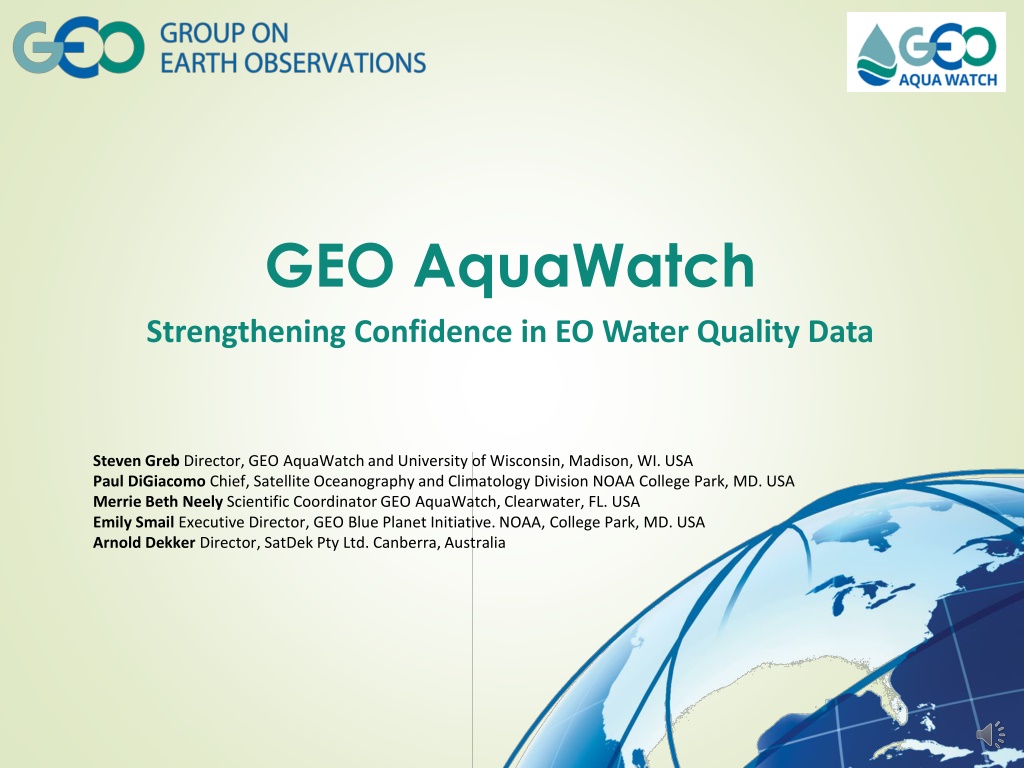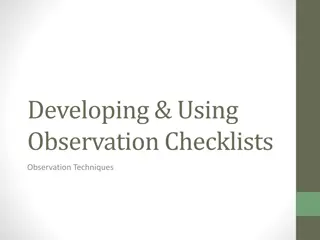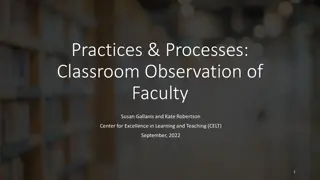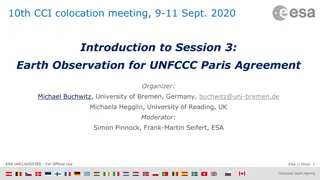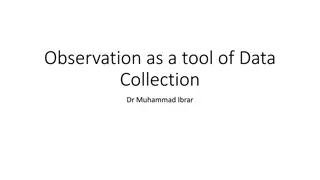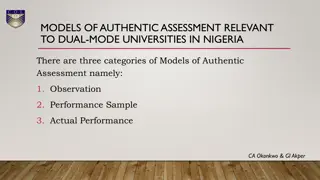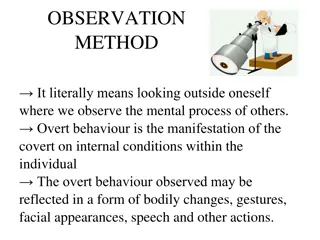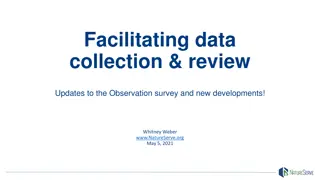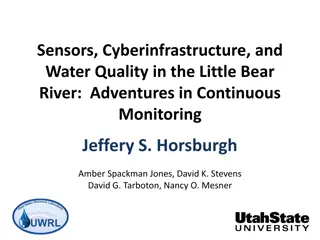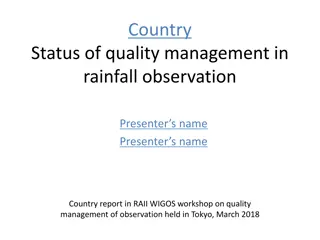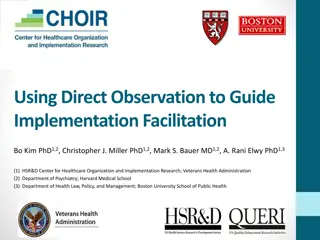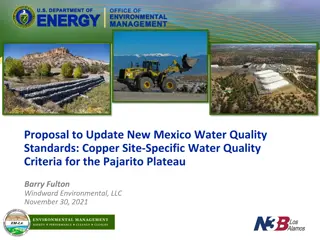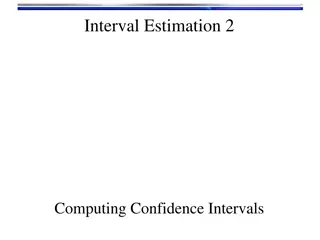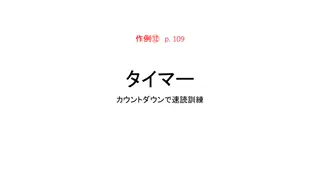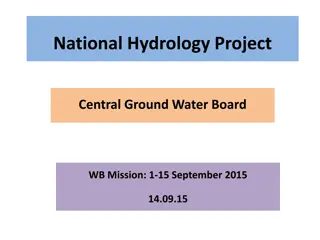Strengthening Confidence in Earth Observation Water Quality Data
GEO AquaWatch focuses on enhancing trust in Earth observation data for water quality assessment and management. Through the utilization of advanced sensor technologies and collaboration, AquaWatch works to provide accurate and validated products to support monitoring and research efforts. Institutional barriers are being addressed to cultivate user confidence and promote the utility of satellite-derived water quality information, ultimately aiming to improve global water resource management.
Uploaded on Oct 10, 2024 | 0 Views
Download Presentation

Please find below an Image/Link to download the presentation.
The content on the website is provided AS IS for your information and personal use only. It may not be sold, licensed, or shared on other websites without obtaining consent from the author. Download presentation by click this link. If you encounter any issues during the download, it is possible that the publisher has removed the file from their server.
E N D
Presentation Transcript
GEO AquaWatch Strengthening Confidence in EO Water Quality Data Steven Greb Director, GEO AquaWatch and University of Wisconsin, Madison, WI. USA Paul DiGiacomo Chief, Satellite Oceanography and Climatology Division NOAA College Park, MD. USA Merrie Beth Neely Scientific Coordinator GEO AquaWatch, Clearwater, FL. USA Emily Smail Executive Director, GEO Blue Planet Initiative. NOAA, College Park, MD. USA Arnold Dekker Director, SatDek Pty Ltd. Canberra, Australia
AquaWatch Impetus Water Quality is a critical global issue today Earth imagery sources represent rich, underutilized trove of information. EO can have a significant impact on framing issues and driving changes in policies and management practices New and improved sensor technologies, novel algorithm development, image availability and processing capabilities have resulted in major advancements in remote sensing of coastal and inland waters Still Institutional Barriers to use Need to build trust and success stories with the end user community In a survey conducted by EPA, Almost unanimously, interviewees wanted assurance that the satellite product could be validated and include reported accuracy or error estimates for their particular waterbodies. Interviewees agreed that if a product was proved to provide an accurate measure in their particular waterbody of interest, they would be open to using those products for their monitoring, research, and assessments. (Schaeffer et al 2013) Photo by REUTERS/Stringer
Group on Earth Observation GEO is an intergovernmental organization working to improve the availability, access and use of Earth observations for the benefit of society
GEO AquaWatch Goal AquaWatch aims to develop and build the global capacity and utility of Earth Observation-derived water quality data, products and information to support water resources management and decision making. Chesapeake Bay Buoy NOAA Image Lakes Mendota & Monona -University of Wisconsin SSEC image
AquaWatch Organizational Model Coordination Outreach and End User engagement Communication Observations and Data Collaboration Education and Capacity Building Water Quality Information Service Distribution, Access and Visualization Products and Information
Current AquaWatch Activities To Strengthen Confidence in EO Water Quality Data Aquatic Analysis Ready Data Compiling Existing Data Sets (RealEarth Portal) Generating New Data Sets (Google Earth Engine) Coordination of Global Validation Efforts Development of Knowledge Hub
Current AquaWatch Activities To Strengthen Confidence in EO Water Quality Data Analysis Ready Data satellite data that have been processed to a minimum set of requirements and organized into a form that allows immediate analysis with a minimum of additional user effort and interoperability both through time and with other datasets. ------------------------------------------------------------------------ Increases the use and impact of satellite data and removes the data preparation burden for less experienced data users Aquatic Analysis Ready Data Compiling Existing Data Sets (RealEarth Portal) Generating New Data Sets (Google Earth Engine) Promotes data quality and consistency through defined specifications Coordination of Global Validation Efforts Development of Knowledge Hub
Current AquaWatch Activities To Strengthen Confidence in EO Water Quality Data Bring together data of varying file formats, naming conventions, and columns, and transforming it into one cohesive data set Aquatic Analysis Ready Data Compiling Existing Data Sets (RealEarth Portal) Grab samples, buoy data, satellite products Generating New Data Sets (Google Earth Engine) Visual display, time series, scroll across sources for data comparison Embedded in AquaWatch Website and linked to GEOSS Coordination of Global Validation Efforts Updated hourly Development of Knowledge Hub
Current AquaWatch Activities To Strengthen Confidence in EO Water Quality Data Development Geospatial Products and Tools A collaborative project between GEO AquaWatch, the World Bank, Conservation International,UNESCO and Google Earth Engine of Global Water Quality Aquatic Analysis Ready Data Compiling Existing Data Sets (RealEarth Portal) The goal of this project is to provide a global- scale, open access, freely available fit-for- purpose chlorophyll-a, total suspended solids and colored dissolved organic matter (CDOM) water quality information for inland and coastal waters to be used by multiple end users including the science community, water resource managers, industry and the general public. Generating New Data Sets (Google Earth Engine) Coordination of Global Validation Efforts Development of Knowledge Hub
Current AquaWatch Activities To Strengthen Confidence in EO Water Quality Data Validation of Satellite-derived Optical and Water Quality Parameters for Coastal and Inland Waters A NASA sponsored workshop Aquatic Analysis Ready Data Compiling Existing Data Sets (RealEarth Portal) Goal: To build a global-scale validation network The workshop will cover a number of aspects related to validation including standardization of protocols, instrumentation needs, current validation research and operational efforts, validation metrics, interoperability of validation data. Experts within both the remote sensing and in situ observational community Generating New Data Sets (Google Earth Engine) Coordination of Global Validation Efforts Development of Knowledge Hub Tentatively Set for June 2021!
Current AquaWatch Activities To Strengthen Confidence in EO Water Quality Data Capacity Building and Training Effort A web-based resource where a compilation of documentation and tools are accessible and freely open to all in the water community. This will be a place where people from around the globe, working across this subject matter, go to exchange knowledge, experiences, ideas, and increase one s expertise. Code, models and tools Aquatic Analysis Ready Data Compiling Existing Data Sets (RealEarth Portal) Resource types Sources Post-prints with DOI stored Open source in Github with DOI. Backups. GEOSS Platform and/or Cloud descriptions GEOSS Platform, Data Repository, and/or KH database GEOSS Platform, Data Repository, and/or KH database Directly stored in the Knowledge Hub (preferably). Generating New Data Sets (Google Earth Engine) Publications Coordination of Global Validation Efforts Remote sensing data Fair Standards Findable Accessible Interoperable Reuseable Development of Knowledge Hub In situ data Results and products Videos, Other
Summary Water Quality continues to be a critical issue locally and globally Multiple streams of Water Quality data products generated on a daily basis. Yahara River, WI. Credits: S. Greb/U. Wisconsin Acceptance of this new technology will require data quality assurances GEO AquaWatch is providing an important platform and forum at a critical time to address these needs WDNR photo
Contact Information If interested in joining a working group or getting involved in AquaWatch, please contact the AquaWatch Secretariat (Merrie-Beth Neely) at info@aquawatch.org Or contact Steven Greb, AquaWatch Director at the University of Wisconsin at srgreb@wisc.edu Visit our website : www.geoaquawatch.org
Comparison of Earth observation sensors Comparison of Earth observation sensors suitable for water quality assessment with public access data policy Landsat-7 Landsat-8 Sentinel-2 Sentinel-3 Satellite and sensor details Satellite sensor system Spatial resolution (m) Spectral Bands Revisit cycle (days) Swath width (km) Launch date ETM+ 15, 30, 60 8 16 185 April 1999 OLI/TIRS 15, 30, 100 11 16 185 February 2013 4/5 MSI 10, 20, 60 12 5 290 June 2015 OLCI 300 21 2 1270 Feb 2016 Years in orbit/minimum design life (years) Suitability for water quality assessment -Highly Suited; -Suitable; -Potential CHL CYP TSM CDOM SD Kd 18/5 2/7 1/7 CHL Chlorophyll, CYP Cyanophycocyanin, TSM Total Suspended Matter, CDOM Colored Dissolved Organic Matter, SD Secchi Disk Transparency, Kd Vertical Attenuation of Light Suitability for water quality assessment from Dekker, A.G. & Hestir, E. L. (2012) Evaluating the Feasibility of Systematic Inland Water Quality Monitoring with Satellite Remote Sensing. CSIRO: Water for a Healthy Country National Research Flagship
